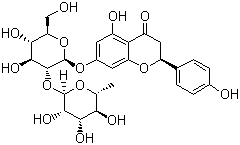
Grapefruit as a kind of fruit from rutaceous evergreen citrus tree is nourishing and popular. It originates from China with a cultivation history of more than 2500 years and usually symbolizes reunion and happiness in family gathering during autumn and winter folk festivals. Modern medical research finds that fresh grapefruit contains ingredients like insulin, naringin, hesperidin, volatile oil, vitamin B1, vitamin B2, nicotinic acid, vitamin C, fructose, glucose, protein, lipid, iron, calcium, phosphorus, and crude fiber, and therefore reveals activities of lowering blood sugar, reducing blood fat, diminishing weight, beautifying skin and so on. Regular consumption of grapefruit exerts an auxiliary therapeutic effect on hypertension, diabetes, vascular sclerosis and other diseases, whereas excessive intake will not only affect the liver detoxification, but also cause other adverse reactions.
It is noteworthy here that naringin as one of the main nutritional ingredients in grapefruit has accepted increasing attention owing to its unique physicochemical property and pharmacological activity. Naringin with a molecular formula C27H32O14 and a molecular weight of 580.4 g/mol is a  flavanone-7-O-glycoside containing flavanone, naringenin at the 7-carbon position and two rhamnose units attached to its aglycon portion, and it appears in a manner of white to light yellow crystalline powder. Flavonoid naringin occurs naturally in citrus fruits, especially in grapefruit, where naringin is responsible for the fruit’s bitter taste, and mainly exists in the peel, capsule and seed. The crystal water content and melting point of pure naringin are different from crystallization and drying methods. In general, it contains 6 to 8 crystalline water with a melting point of 83oC, while a crystal containing 2 crystalline water could be obtained through drying at constant temperature 110oC with a melting point of 171oC. It is slightly soluble in water and completely soluble in hot water, ethanol, acetone and subfebrile acetic acid. Its aqueous solution is weakly acidic due to the existence of phenolic hydroxyl group, and the product “curcumin dihydrochalcone” after hydrolysis and hydrogenation is a kind of sweetener with sweetness about 150 times higher than that of sucrose. Since naringin is readily soluble in alcohol and alkaline liquor, and can also be dissolved in hot water, it is usually extracted via alkaline and hot water process, which is performed in a following sequence: pomelo peel is comminuted first, leached in alkaline hot water and then filtered. Subsequently, the filter liquor is cooled and precipitated, thus getting the desired solid, which undergo a sequential procedure of separation, drying and crushing to provide the final products.
flavanone-7-O-glycoside containing flavanone, naringenin at the 7-carbon position and two rhamnose units attached to its aglycon portion, and it appears in a manner of white to light yellow crystalline powder. Flavonoid naringin occurs naturally in citrus fruits, especially in grapefruit, where naringin is responsible for the fruit’s bitter taste, and mainly exists in the peel, capsule and seed. The crystal water content and melting point of pure naringin are different from crystallization and drying methods. In general, it contains 6 to 8 crystalline water with a melting point of 83oC, while a crystal containing 2 crystalline water could be obtained through drying at constant temperature 110oC with a melting point of 171oC. It is slightly soluble in water and completely soluble in hot water, ethanol, acetone and subfebrile acetic acid. Its aqueous solution is weakly acidic due to the existence of phenolic hydroxyl group, and the product “curcumin dihydrochalcone” after hydrolysis and hydrogenation is a kind of sweetener with sweetness about 150 times higher than that of sucrose. Since naringin is readily soluble in alcohol and alkaline liquor, and can also be dissolved in hot water, it is usually extracted via alkaline and hot water process, which is performed in a following sequence: pomelo peel is comminuted first, leached in alkaline hot water and then filtered. Subsequently, the filter liquor is cooled and precipitated, thus getting the desired solid, which undergo a sequential procedure of separation, drying and crushing to provide the final products.
The unique chemical structure of naringin endows it various biological activities, and thereby it shows prominent utilization potentiality in many fields with tremendous economic value. In food industry, it can be mainly used as food additive for gum and cool drinks. It could also serve as bitterant due to its conspicuous bitterness comparable to quinine. In commercial grapefruit juice production, the enzyme naringinase that has a wide occurrence in plants, yeasts, and fungi and is commercially attractive due to its debittering properties can be used to remove the bitterness created by naringin. Inhumans naringin is metabolized to the aglycone naringenin (not bitter) by naringinase. Meanwhile, it can be a kind of raw material to synthesize novel sweetener dihydronaringin chalcone and hesperidin dihydrochalcone with high sweetness, nontoxicity and low energy. Naringin could also be applied as an effective constituent in dietary therapy, which is competent to invigorating stomach, dissipating food, eliminating phlegm, suppressing cough, and neutralizing alcoholism, and is beneficial to relieving diseases like dyspepsia, abdominal distention, cough, phlegm, dysentery, diarrhea, and pregnancy tastelessness. In medical field, naringin also exhibits diverse pharmacological effects like anti-inflammatory, anti-virus, anti-cancer, anti-mutation, anti-allergy, anti-ulcer, analgesic, antihypertensive and inhibitory activities against selected cytochrome P450 enzymes. Moreover, naringin also blocks the TNF-α–mediated inflammatory process and tissue damage in liver and vasculature. Most of naringin’s expressed bioactivities are connected to some degree with its potent antioxidant nature. However, the antioxidant potency of naringin is less potent compared with naringenin because the sugar moiety in the former results in a steric hindrance of the scavenging group. In addition, naringin can reduce blood cholesterol to inhibit the formation of thrombus, and improve local microcirculation and nutrition supply, thus preventing and treating cardiovascular and cerebrovascular diseases by influencing AMPK–, PPARα–, and CPT-1–mediated fat utilization and preserving mitochondrial function.
Naringin supplementation has proven to be efficacious for the treatment of metabolic syndrome and obesity in animal models, and a dietary recommendation on citrus fruit or the pure compound naringin consumption has been established. Another consideration for oral administration of naringin is the contraindications of taking certain drugs such as statins and calcium channel blockers due to the inhibitory effects towards intestinal CYP450 enzymes.

Leave a Reply